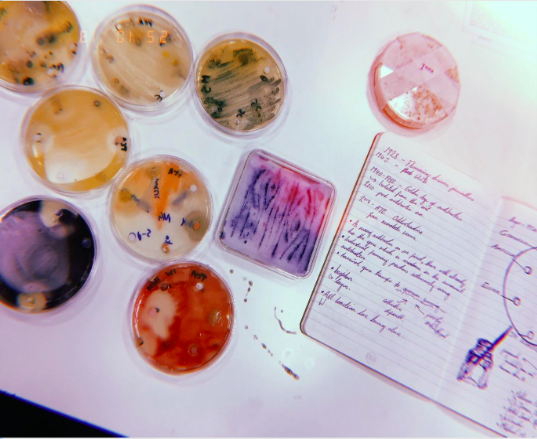
In the Lab by Iona Walker (2019)
Military metaphors
Antimicrobial resistance (AMR) is an urgent global challenge as the antibiotics which once protected us so diligently from infection and illness become increasingly ineffective. Responses to AMR are often centred in, and characterised by, militaristic metaphors and approaches. We talk of “fighting” the “invading” “superbugs” with “magic bullets” as we engage in an “arms race against bacteria” to find the next effective antibiotic (Hall, MacDonell, and O’Neil, 2018, p.43). Headlines proclaiming the antibiotic apocalypse speak to the threat of immanent crisis as public health campaigns are structured around military style framings. Yet as conventional therapies to “kill bugs” decline in effectiveness, research increasingly asserts the integral role of microbiome in human health (Pflughoeft and Versalovic, 2012; Man, De Steenhuijsen Piters, and Bogaert, 2017; Gilbert et al., 2018). Where did this military language come from and how can we imagine the future of human/microbe relationships?
The language we use to articulate our relationship with the world informs, reflects, and reinforces how we understand and construct our realities (Haraway, 2000; Sontag, 2007; Semino, 2008). However, relatively little attention is paid to the consequences of a military framing for our understanding of bodies, knowledge making practices and wider environment. This is significant as the human body is comprised to a large extent of bacteria and fungi such that our bodies are composed not of mass which is genetically “us” but instead constitute an ecosystem of microbial life. Therefore, there is a tension between the war metaphors used for “germs” and the symbiotic relationships with microbes necessary for human wellbeing.
Magic bullets
Tracing the historical roots of this language can help unravel the assumptions, agendas, and underpinnings behind it. The history of microbiology offers insights into how biological discourse has subsequently influenced knowledge production inside laboratory spaces, public opinion, and representations of AMR. From the nineteenth century, humans have understood microbes primarily as pathogens. After Louis Pasteur revolutionised modern medicine by creating the means to identify microbes as agents of disease, Robert Koch produced “magic bullets” (antibiotics) to quell infectious threats. By giving the age-old scourge of disease a recognisable, definitive form, Pasture and Koch provided the means to transform previously unknowable entities into a “common enemy” to be defeated in the name of the common good. The subsequent mass production of antibiotics meant that for the first time in history, physicians and surgeons could identity the cause of infection and control it.
Although Pasteur himself was driven by curiosity rather than warfare in his study of microbes, his discovery did more than alter scientific theorising. Public health, infectious disease medicine, hygienists and others invested in eliminating microbial threats begun to initiate a change in the way the world had to be constructed in order to assert human control over life itself (Paxson, 2008). Pasture’s microbes were discovered and controlled within the confines of the laboratory; therefore, the outside of the world began to be provisioned with lab-like surveillance and infrastructure. Today we recognise terms like “biosecurity” from government discourse, with institutions such as the Centre for Disease Control endowed with military-like powers to enforce lockdowns, secure zones, and set up outposts on foreign soil.
The tension created by the need to treat infectious diseases while acknowledging the life sustaining role played by microbes is an important one. While disease causes suffering, overuse of antibiotics or cleaning products can cause chronic health conditions through disrupting the balance of the microbiome (Bloomfield et al., 2016; Wolf-Meyer, 2017; Greenhough et al., 2018). The microbiome influences immunity, digestion and even our brain chemistry. Life without it would not be possible. As further research emerges regarding the importance of the microbiome for human health, the notion that humans are individual fortresses against the “microbial onslaught” (Tsing et al., 2017) is not only too simplistic, but is limiting our ability to reimagine new possibilities. Art is one way to transcend language and expand the possibilities for understanding the microbial world we live with.
Art and the “disrupted body”
Reimagining the human relationship to the microbial beyond the military metaphor requires confronting what it means to live in fundamental interdependence with these non-human others (the majority of microbes are either directly beneficial or neutral towards humans). Often this requires re-thinking categorisations of between the self and other, purity and danger (Douglas, 2002). However, disrupting the sanctity of previous stable bodily boundaries can be an uncomfortable project. Mark Fisher states that “Freud’s unheimlich” — translated to mean “uncanny” or “unhomely” – “is about the strange within familiar” (Fisher, 2016). In this case, confronting the uncanny microbes living inside the familiar body without means to control them evokes emotion, creates tension, and demands response.
Art and contagion have a long history. Depictions of plagues, treatments, and bodies affected by microbial encounters provide insight into attitudes, beliefs, and understandings of health in the past. In the present artistic engagement can transcend language, create opportunities for curiosity about new ways of perceiving the body. Art has dealt with questions of the disrupted body through the evoking the abject, which reveals tangibly the “uncanny” truths about the ecological nature of the “human” body. An example might be the revulsion we may feel seeing cultures of bacteria sampled from human bodies. Artists working with the microbial world can use the power of the abject to challenge understandings of the more-than-human body. Bioartist Sonja Baumel’s works Expanded Self (2012) and Oversized Petri dish (2009) make visible the microbes that live in tandem with her resulting in an uncanny self-portrait. Baumel’s work illustrates her healthy body as an entity inseparable from its non-human kin. Her work transforms the familiar medium of the self-portrait into something unexpected and unsettling – troubling the viewers understanding of “self” (Figure 1).
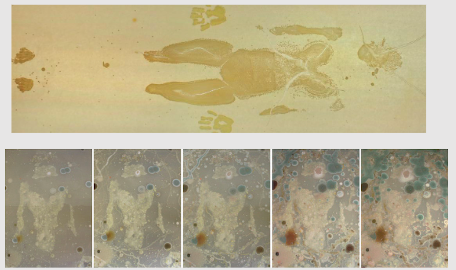
Figure 1: Sonia Baumel. Expanded Self (2012) and below: Oversized Petri-dish (2009)
Rebecca Harris’ textile work Symbiosis (2015) uses the microbiome to embellish rather than blemish the body. Her use of colour and everyday material (cloth and thread) invite tactile engagement, wonder and curiosity as well as evoking the existence of “everyday microbes” outside of the lab. The “corporeal, embodied nature” (Greenhough, 2012: 291) of human-pathogen encounters – illness – often leaves traces, marks, and scars which can invoke stigma, fear, and victimisation (examples include leprosy, smallpox). Harris transforms the uncanny microbe into something new, demonstrating the nested ecosystems of living human, microbe, and foetus. The pregnancy highlights the ways in which infants acquire their microbiome after birth and raises questions around the safety of rising Caesarean-section rates in the age of AMR (Figure 2).
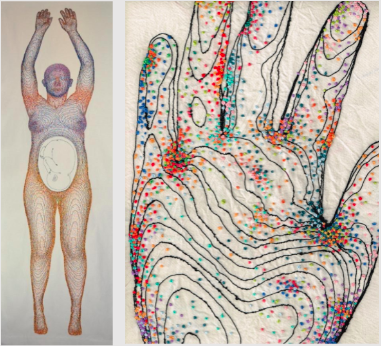
Figure 2: Rebecca D. Harris. Symbiosis, embroidery on fabric (2015)
Sarah Craske’s work The Disease Map (2018) is a time-lapse film of Vibrio Cholerae interacting with synthetic peptides across a map of Basel by Matthäus Merian. Craske’s work invites use to consider the disease map as both an epidemiological tool throughout history and also the ebb and flow of human pathogen interactions over time. Craske addresses antibiotic resistance directly, using an antibiotic substance to suggest the limits of human disease control and highlight the ways humans create conditions for disease to flourish (Figure 3).
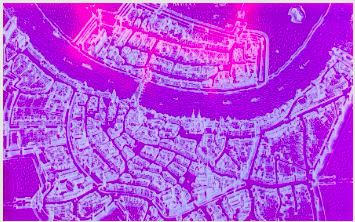
Figure 3: Sarah Craske. The disease map (2018)
Finally, “Germs Gone Global” is a submission to the American Society for Microbiology Agar Art Competition. The artist has cultured common drug resistant “superbug” methicillin-resistant Staphylococcus aureus (MRSA) to illustrate a world map. The artist urges us to consider the impact of a globally connected world on the spread of potentially deadly microbes (Figure 4).
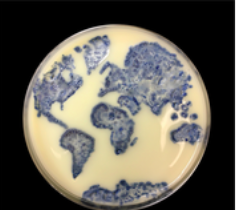
Figure 4: American Society for Microbiology Agar Art Contest 2017. ”Germs Gone Global,” Elizabeth Tremblay, MPH, CPH, CIC. Copyright © 2017 American Society for Microbiology. All rights reserved.
MPH, CPH, CIC. Copyright © 2017 American Society for Microbiology. All rights reserved.
Conclusion
Microbes are here to stay. Bacteria, fungi, and viruses are the oldest organisms on the planet, they are integral to life on Earth. The human body itself is comprised to a large extent of microbes such that our bodies are composed not of mass which is genetically “us” but instead an ecosystem of microbial life. The advent of antibiotics enabled modern biomedicine to treat infectious diseases and control the human relationship to the microbial. Subsequently, antimicrobial resistance has become an urgent global challenge; antibiotics which once protected us so diligently become increasingly ineffective against infection. Thus, humans are approaching a critical juncture: in the era of AMR can we look beyond the military metaphor? What does it mean to live with microbial life that at once sustains and threatens human wellbeing? What tools, questions and expertise are required?
That is why in my PhD Project I am trying to understand how the limits, possibilities and consequences imposed and created by the military metaphor shape scientific research pertaining to AMR. Using ethnographic methods informed by feminist multispecies scholars such as Anna Tsing I pay attention to more-than-human science making practices. In addition, I use speculative fiction, poetry, and other imaginative literary works to reflect on the possibilities for new languages and conceptions of human-microbe relationships. These questions contribute to conversations in medical anthropology, science, and technology studies about living in the Anthropocene. However, many disciplines are concerned with AMR. In order to transcend silo thinking and combine our expertise I established the BEYOND RESISTANCE Network. The network exists to facilitate conversations and catalysing collaborations between the medical sciences, humanities, arts, and social sciences. In doing so, we might be better placed to invent new ways of investigating and imagining AMR.
PhD Student in Social Anthropology at the University of Edinburgh